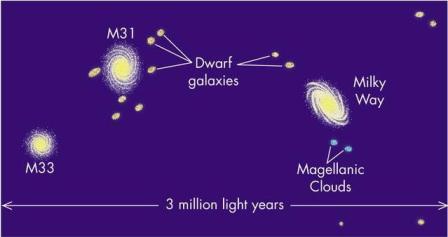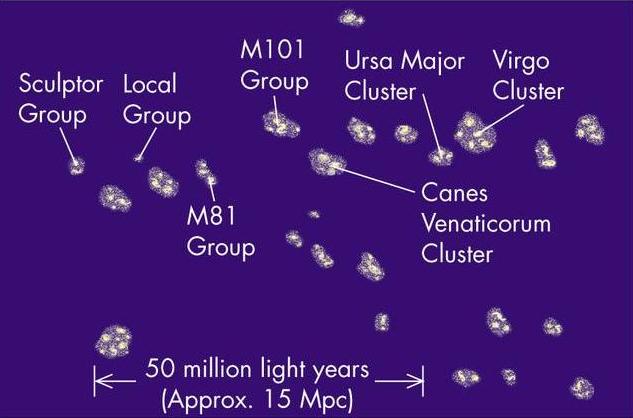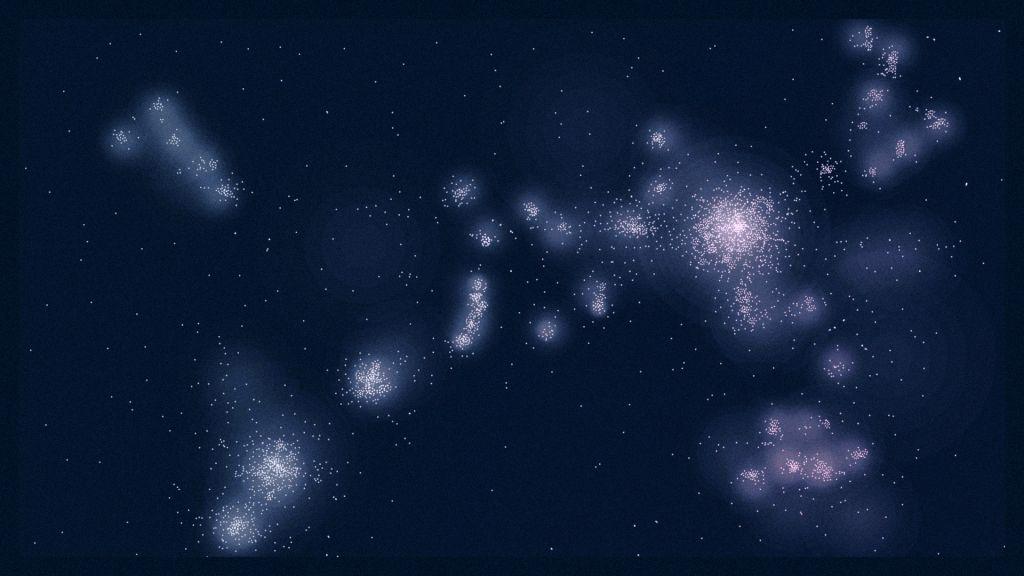On the likelihood of rare events
|
Our
natural environment sets the stage for ranking any event as
frequent or rare. Usually, these probabilities cover a few orders
of magnitude. Evolution found it irrelevant to teach us the true
features of the real world. Therefore, we have no spontaneous feeling
for such information like 'our galaxy consists of about 100 billion
stars' or 'our brain contains about 80 billion neurons'.
|
It took some generations of research and expensive instruments to
arrive at these numbers. Both statements contain the word 'about' for a
simple reason: neither of these numbers (by coincidence roughly the
same) can be obtained by counting. We are used to count by
consecutively pointing at the items in question. If one act of pointing
would take one second, we would be able to count 86.400 items during a
whole day and night (24 h) of uninterrupted monitoring. It would take 11
1/2 days to arrive at one million. To arrive at one thousand million,
it would be necessary to continue the monotonous pastime for more
than 30 years (without sleeping breaks).
|
Let's
now consider a particle / wave entity bidding farewell to its entangled
partner somewhere in this universe, both leaving their point of birth
in contrary directions. As long as neither of them hits any target,
their mysteriously shared condition will persist. According to our
present (2/25) state of knowledge, no other fact (than hitting a
target) limits this persistence. Hypothetically, they might even leave
the galaxy and continue to neighboring ones (we are not yet sure about
this).
|
Our
universe is estimated to contain roughly 100 billion galaxies (once
again this enigmatic number). Of course there is a lot of empty space
between them, but sooner or later one or even both of our particles
will arrive at one of them. This still does not mean they will hit any
target. They (hypothetically) could pass without any encounter - but
behind, the next
galaxy will be waiting (they have a lot of patience, these galaxies).
|
To
estimate the likelihood of rare events, we first must get a feeling
for very high numbers. No mystery must hide behind expressions
as 'million' (10 to the exponent 6) and 'billion' (10 to the exponent
9, US-american style). On the other hand, we also have to remain on the
firm ground of reason. The probability that a technically evolved
civilization exists in our milky way is 1 (equivalent to the notion
that humankind does exist). After all we know, nothing spooky was
required to allow our emergence. Similar processes might have come
spontaneously into being also in other planetary systems.
|
Given
the vast distances even within our own galaxy, it will be difficult (if
not impossible) to get sure knowledge of other galactic civilizations
(not to mention extra-galactic ones). The only fact we can be sure
about is our own existence. Another fact we may anticipate with some
confidence is:
there are
(quite a few) similar civilizations elsewhere in the universe. It
appears as a conservative estimate, to expect their total number to be
at least as high as the number of galaxies. And I am optimistic: highly
developed civilizations are no short-lived phenomena; they have the
resilience to stay as long as their planetary system allows.
|
At
this point of our comtemplation, we redirect our attention to our
lonesome particles travelling the empty space. Maybe to their
consolation, they still 'know' that they are miraculously bound into a
single entity with their far away partner. Let us now assume, one of
them arrives at our earth and hits a target (be it a simple stone or
the sophisticated instrument of a terrestrial explorer). At this magic
moment, its state will be reduced from an indifferent either / or to one of these possibilities. At the same time, its far away
partner will do the same: fall back to one single state from the
original either / or (without having hit any target).
|
Up
to now, entanglement of any objects (photons, atoms, even whole molecules) has only been studied
in experimental settings. To the best of imaginative power,
we presently have no idea how to explore the potential
entanglement of natural objects. On earth, they arise largely from our
sun, but also from more or much more distant sources. Here, we focus on
the latter ones. They may have been produced (together with their
entangled partner) thousands or even millions of lightyears away. Our
milky way has a diameter of ca. 100.000 lightyears, and our next
neighbor (Andromeda) is at a distance of ca. 2.500.000 lightyears. If
entangled particels would be produced half way between such distant
locations leaving their point of origin in contrary directions, they
would reach them at the same time.
|
Entangled photons may be produced in interstellar dust (nebula) by positrons emitted by stars. In comparison to charged positrons, annihilation photons generated by positrons hitting ordinary matter will have a much longer mean free path. Therefore, they have a realistic chance to
leave the dust cloud without encounter. Cosmic nebula may extend over
100 lightyears or even more. It would be a matter of chance, from which
part of the dust cloud such particle pairs are generated. Their source
of origin varies across a wide range, and some of them may lie very
close to a midpoint between two very distant star systems each
inhabited by a technically evolved civilization.
|
I
recently proposed to include the acts of observation and of hypothesis forming into
the formalism suitable for the description of reality, blending (at
least) 3 more dimensions into our conventional 4-dimensional space-time
(The whole world in your little TOE). I admit that this was a
purely intuitive proposition and that I lack the mathematical expertise
to elaborate on it in any detail. Further steps to advance our
understanding of reality may include the exchange of information with
other developed cililizations in the universe. Here, I try to point out a speculative scenario for such contacts.
|
| Since
the number of galaxies is estimated to 100 billion, this opens
quite a couple of possibilities for communication. The spontaneous
formation of a bi-forked stream of entangled particle / wave entities
and their direction exactly towards two planetary systems with
technically evolved civilizations, furthermore in the same (+/- a few
lightyears) distance from the source, may on first glance
appear as all too unlikely, but with 100 billion potential partnes at
hand (or even more, if we assume more than one per galaxy) there might
be a realistic chance. The number of galaxies increases with the quare
of distance, but also the risc of prematurely hitting any target
increases with the distance covered. |
It
will be essential to deal with a beam putatively containing entangled
particles far away from earth (and moon) to guarantee its free passage.
This free passage would be interrupted occasionally at our will for
observation and measurement. It may be mandatory to do this
deliberately, introducing the momentum of personal decision into the
chain of events, paying tribute to a reality that may rely on more
dimensions than our current textbooks know. Systematic switching
between periods of
observation and periods of free passage may generate non-random short
pulse changes in specific properties of the other arm potentially
observed by a far distance civilization (and vice versa). To reduce the
risk of large investments, the strategic details should first be tested on
conventional scales.
|
The
actual state of entanglement research allows no suggestion as to which
'specific properties' this might be. Furthermore, it is unknown whether
particles can stay entangled over cosmological distance. We should not
expect immediate results. The source of the bi-forked radiation will
never be exactly between us and our potential communication partner.
First rudimentary non-random fluctuations may only appear after a
few years. Nevertheless,
such a project maybe our only chance to exchange information with
non-terrestic civilizations on a pragmatic time-scale. Its
realisation may appear unlikely today, but may be feasible in the near
future. Maybe the current dogma, that no information can travel faster
than light, is not justified. We may share entangled moments with more
corners of the universe then we deem possible.
|
illustration (7 power point slides)
illustration 2 (15 power point slides)
|
1/25 < MB (2/25) > 3/25
|
see also: The power of chance
back to Cosmology
|



